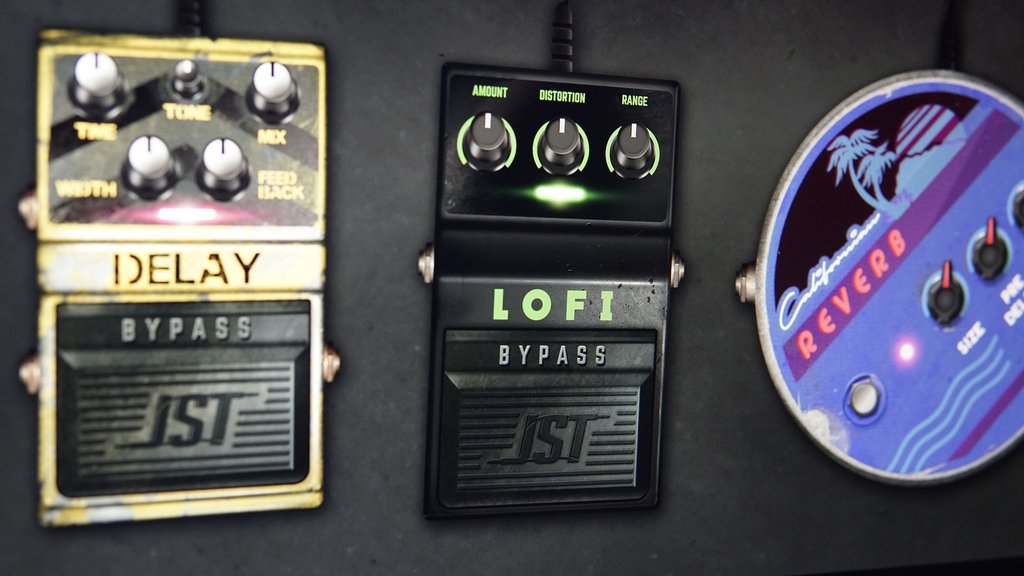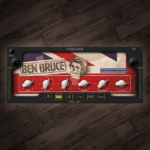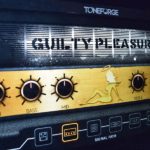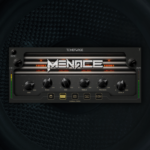New Software Review: Toneforge Amp Collection from Joey Sturgis Tones
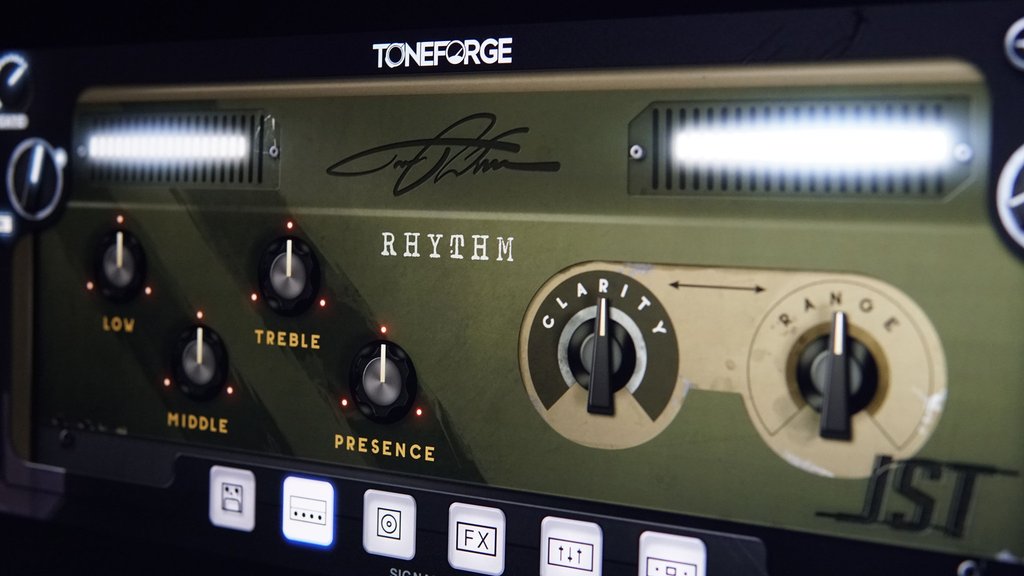
The GUIs for the entire Toneforge range are simple and intuitive, making it easy to quickly dial in a mix-ready tone and focus on tracking.
The amp simulator market has come a long way in the past few years. Not only are amp sims sounding better and better, but they are getting cheaper and cheaper as well. One line of amp sims with rising popularity is the Toneforge line from Joey Sturgis Tones.
Recently, JST released the Toneforge Jason Richardson signature amp, so what better time to review the whole line than now? The lineup currently features four amps: Toneforge Menace, Toneforge Ben Bruce, Toneforge Guilty Pleasure, and of course, the new Toneforge Jason Richardson.
These JST amps are marketed as “guitar tone simplified,” offering straightforward and intuitive GUIs for amps that deliver a mix-ready tone for those with limited time and budget.
Features
Each of the four amps operate similarly, but all have unique feature sets that give each their own space in the line. Overall, each amp features a front panel to tweak the settings, a cabinet and microphone selection, an EQ, compressor, and an Impulse Response (IR) loader. After that, it’s all just icing on the cake.
Let’s start at the top of the line with the original Toneforge Menace. Since it was the first, it is the most bare-bones amp of the collection, and the one that set the framework for further iterations.
The amp features a “green overdrive” pedal (seemingly a not-so-subtle nod to the revered Ibanez Tube Screamer) in front of the amp that can be switched on or off. This amp has just one cabinet with four preset microphones. At $79, not only is Menace among the cheapest of the bunch, but it is also the most strictly limited in scope. There’s not a whole lot to experiment with, but it does provide a strong starting point for heavy guitar tones.
The next to be released was Toneforge Ben Bruce, which tweaked the original Menace into a signature amp from the Asking Alexandria guitarist. This iteration really opens up the line in terms of features, which is reflected in the increased $99 price point.
In addition to an overdrive stompbox, a reverb, delay, and rotary effect were all added to the Ben Bruce amp, reducing the need to venture outside of this single plugin in order to craft a more complete tone. The amp also features a clean channel that the original didn’t, giving it some extra versatility.
For Toneforge Guilty Pleasure, JST stripped back the feature set again, focusing more on making one great amplifier that can cover a wide range of tone. At a price point of $79, Guilty Pleasure’s sound can range from active rock to full-out metal.
There is a single channel front panel amp with a “black” overdrive stompbox in front. In the effects loop, there is the option for a delay, reverb, and for the first time a wah pedal, designed to “just work” with the amp, says JST.
I’ve never been a fan of virtual wah pedals because without the real-time performance aspect, I feel the whole purpose is defeated—but it’s there if your automation game is on-point. While Guilty Pleasure is without a clean channel, it does gain a new cabinet. On the back end is another EQ and compression chain that has been “redesigned.”
The most recent addition to the line—Toneforge Jason Richardson—is the most unique and the most comprehensive of the bunch.
Priced at $99, there is no overdrive stompbox (probably due to the fact that the tone it’s based off of does not utilize one) and instead includes delay, reverb and lo-fi effects. While it may seem like the same old pedals, I found that these are the best of the entire JST line so far.
The Jason Richardson amp is accompanied by two impulses, this time with a nameless JST cab and a PRS 4×12. On the end of the chain is EQ and compression again, but this time modeled after the chain used to achieve the tone on Jason Richardson’s album “I”.
The largest difference however, is that this is a three-channel design. There is a clean, rhythm, and lead channel, each of which offers quite a wide range of tones—a big difference from the rest of the line.
On the front panel of each section, the amps include unique controls such as “Edge” and “Shimmer,” and feature the ability to make the input drive the amp instead of a dedicated gain knob. This design makes Toneforge Jason Richardson stand out from the rest of the collection, and offers a little more room for creative exploration when dialing in tones.
In Use
Each of the four amps in the Toneforge collection bring their own strengths and weaknesses to the table. However, there is a certain thread among the entire line that ties them all together, making them feel like a cohesive whole—but that’s not to say they all sound the same.
- A glimpse at a few more of the models in the Toneforge series.
The winning aspect that all of the Toneforge amps share is their ease of use. These plugins were designed to be as mix-ready as possible right off the bat, and although you can fine-tune their parameters, the idea is for you to stop worrying about dialing in a tone and start worrying about making good music.
In fact, there aren’t a whole lot of ways to make the amps sound bad, especially if you don’t mess much with the EQ and compression. I found myself only dialing in tones manually if I really felt the need to, because most of the time, with any of the amps, they just worked.
Since they are designed to be so easy to use, I often found myself switching to another amp from the line to find the tone I wanted instead of tweaking the one that was already in place. While each can be finessed to get closer to what you’re looking for, I found it was more convenient to simply switch to another model. Generally, this method got me to my goal faster than anything else.
Thankfully, switching around between the whole line is a breeze. Unlike most amp sims on the market, the Toneforge line just barely kisses the CPU, making it perfect for productions that demand lots of layers of guitar.
To Be Critical
While the simplicity of this range has its upsides, it also has its downsides. Guitars are one of those elements where tones can (and often should) vary drastically—even within the same mix—so using the same treatment globally may be ineffective when dealing with many layers of guitar tracks. Additional amp models or further plugin treatment may be necessary, especially in denser mixes.
The intentional limitations of the Toneforge line, while convenient and useful, can also be a bit crippling when you want to venture outside of the realm that is defined by each of the amps. It may seem, upon first inspecting the parameters of each amp, that the tonal palette is pretty huge. And while there is certainly sculpting that can be done within the plugin, the fundamental tone stays relatively the same.
That’s not inherently bad, and is arguably much like working with a real tube amp in some ways. It just makes for an incredibly limited range of tones within each plugin. This kind of simplicity can be a blessing or a curse, depending on the application and your tastes.
Ultimately, I found these amps to be one-trick ponies. While that trick works very well for what it’s intended for, it doesn’t offer the wide range of sounds that the more expensive and CPU-taxing amp sims on the market do.
Summing it Up
JST has done a lot with the Toneforge line in the few years since its inception, and I’m excited to see where the line will go next.
Although there may not be enough variation in the collection for you to get everything you’ll ever need in a guitar tone, Toneforge will certainly take you pretty far along.
Having had access to the collection for a little while now, I find I generally reach for these amps first, and although they work most of the time, I do find it very important to have other amps readily available for when variety is needed.
The Toneforge line can be of great use for those who want to jump into tracking guitars immediately without much fiddling around. They’re easy on CPU, offer great tones instantly, and are by far the most convenient amp simulations on the market.
Jacob Roach is a writer, producer, and engineer from St. Louis, Missouri.
Please note: When you buy products through links on this page, we may earn an affiliate commission.







